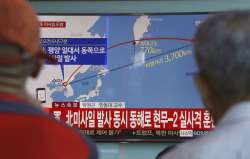North Korea fires another missile over Japan, UNSC convenes emergency meeting
North Korea has fired an unidentified missile from its capital Pyongyang that flew over Japan before landing in the northern Pacific Ocean, Seoul and Tokyo have said

North Korea has fired an unidentified missile from its capital Pyongyang that flew over Japan before landing in the northern Pacific Ocean, Seoul and Tokyo have said. The test-flight, the second over Japan in less than a month, follows one of the most powerful nuclear tests by North Korea on September 3. The test was considered the sixth most powerful nuclear test by North till date.
South Korea’s Joint Chiefs of Staff said the missile traveled about 3,700 kilometers (2,300 miles) while reaching a maximum height of 770 kilometers (478 miles). Japan’s J-Alert system, on the other hand, said the missile flew over Hokkaido in northern Japan "at around 07:06 am (2206 GMT) towards the Pacific Ocean", Reports claimed that the rocket came down around 2,000 kilometres east of Hokkaido.
The missile was launched from Sunan, the site of Pyongyang’s international airport, the same place North Korea used last month to fire a Hwasong-12 intermediate range missile that flew over northern Japan. The test-firing, which North Korea claimed to be a hydrogen bomb small enough to fit a missile, came as part of a string of similar provocations leading to tensions in the region over the rapid rise of the country’s weapons programme.
The North then declared it a “meaningful prelude” to containing the U.S. Pacific island territory of Guam and the start of more ballistic missile launches toward the Pacific Ocean.
North Korea's latest missile test comes just a day after it said it will 'sink' Japan and that the US will be reduced to "ashes and darkness".
The Korea Asia-Pacific peace committee, which oversees North Korea's relations with the outside world, described the UN Security Council, which passed a new round of sanctions earlier this week, as a "tool of evil" in the pay of Washington, and called for it to be broken up, the Guardian newspaper reported on Thursday.
"The four islands of the (Japanese) archipelago should be sunken into the sea by the nuclear bomb of Juche," the committee said in a statement carried by the official KCNA news agency.
Japan’s Chief Cabinet Secretary Yoshihide Suga has denounced North Korea’s latest launch, saying he was conveying “strong anger” on behalf of the Japanese people. Suga said Japan “will not tolerate the repeated and excessive provocations.”
North Korea’s latest provocation follows the imposition of the eighth set of sanctions on the country by the United Nations Security Council over its banned missile and nuclear programmes.
The North American Aerospace Defense Command determined the intermediate range missile did not pose a threat to North America. In addition, U.S. Pacific Command said it did not pose a threat to Guam.
South Korean experts said the August launch was Pyongyang’s attempt to make missiles flying over Japan an accepted norm as it seeks to test new missiles and win more military space in the region dominated by its enemies.
The Offices of Guam Homeland Security and Civil Defense said the latest launch posed no immediate threat to Guam or the Marianas.
South Korea’s Defense Ministry said the country’s military conducted a live-fire drill of a Hyunmoo-2 ballistic missile in response to the North’s launch on Friday.
Seoul’s presidential office said President Moon Jae-in has scheduled a National Security Council meeting to discuss the latest launch.
North Korea claimed its latest nuclear test was a detonation of a thermonuclear weapon built for its developmental intercontinental ballistic missiles.
The North flight-tested its Hwasong-14 ICBMs twice in July and analysts say the missiles potentially could reach deep into the U.S. mainland when perfected.
North Korea initially flight-tested the Hwasong-12 and Hwasong-14 missiles at highly lofted angles to reduce range and avoid neighboring countries.
The two launches over Japan indicate North Korea is moving toward conducting launches at angles close to operational as it seeks to test whether the warheads survive the harsh conditions of atmospheric re-entry and detonate properly.
Meanwhile, the United Nations Security Council has convened a meeting at 3 p.m. EDT (1900 GMT) on Friday on North Korea’s latest missile test, diplomats said, at the request of the United States and Japan.
The 15-member Security Council unanimously stepped up sanctions against North Korea on Monday over its Sept. 3 nuclear test, imposing a ban on the country's textile exports and capping imports of crude oil. It was the ninth UN sanctions resolution adopted on North Korea since 2006.
North Korea has been accelerating its nuclear weapons development under leader Kim Jong Un, a third-generation dictator in his 30s, who has conducted four of North Korea’s six nuclear tests since taking power in 2011.
His military has maintained a torrid pace in testing weapons, which also include solid-fuel missiles designed to be launched from road mobile launchers or submarines.
In his aggressive pursuit of nuclear weapons, Kim is seen as seeking a real nuclear deterrent to help ensure the survival of his government and also the stronger bargaining power that would come from it.
